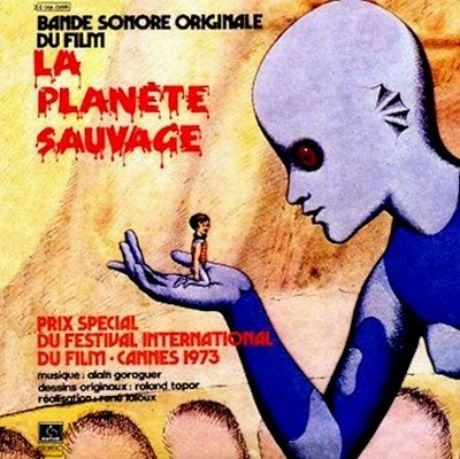
Right then, if you didn't already know, here's the skinny. Animated sci-fi masterpiece La Planète Sauvage (a.k.a.Fantastic Planet), winner at Cannes Film Festival in 1973 and a staple on BBC1 during the Summer holidays in the 70's when I was a kid is an eminently both bizarre and beautiful film. If you've seen it before, watch it again, if you've not then expect towering blue-skinned figures, tiny humanoids in the midst of revolt, and drug induced tantric sex, vividly magical settings. Whats not to like amongst that then eh? The film takes place in the future in which human beings, known as 'Oms' (which I believe refers to the French word hommes, meaning men), have been brought to the 'Draags' home planet, where they are kept as pets with special collars. The Draags are an alien race, humanoid in appearance but a hundred times larger than humans, with blue skin, fan-like earlobes & protruding red eyes. But I’m not going to go into detail about the film. That should be enough to pique the interest of anyone who's into giant blue people and the other stuff I mentioned. The film is ancilliary as far as this piece is concerned. What I want to concentrate on is the soundtrack. An absolutely remarkable thing in it's own right. The music is by Alain Goraguer who's first brush with fame came in 1965 when France Gall won the Eurovision Songfestival with “Poupeé de cire, poupeé de son,” written by Serge Gainsbourg and orchestrated by Goraguer. Afterwards he went on to create music for other French films, including several other animated ones, The Dead Times (Les Temps Morts)(1965) & The Snails (Les Escargots) (1965), both by René Laloux & Roland Topor, who are also responsible for La Planète Sauvage. The music more than lives up to the heady psychedelic world created in the film. Lush arrangements, funky drums, wah-wah guitar, organ, flute and harpischord fill the instrumental soundtrack placing it somewhere between Eno, Morricone and Broadcast. The official soundtrack, also released in 1973, has been often described as a mash-up between Pink Floyd and Isaac Hayes’ Shaft. And thus, has become a definite source for beat digging and sample searching with the likes of Dilla, Shadow, Madlib, Air and Cornershop raiding it. Anyhoo, the album has been reissued a few times now and doesn't take much tracking down, much to the dismay of many a record snob, although I don't see how that could possibly detract from the value of what is a truly precious piece of music.
Till next time. Big love. Mark. X
No comments:
Post a Comment